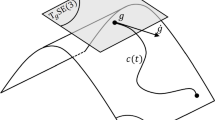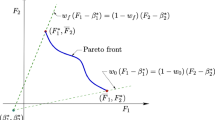Abstract
The problem of minimizing the energy of a system of \(N\) points on a sphere in \({{\mathbb{R}}^{3}}\), interacting with the potential \(U = \tfrac{1}{{{{r}^{s}}}}\), \(s > 0\), where \(r\) is the Euclidean distance between a pair of points, is considered. A method of projective coordinate descent using a fast calculation of the function and the gradient, as well as a second-order coordinate descent method that rapidly approaches the minimum values known from the literature is proposed.










Similar content being viewed by others
REFERENCES
M. Fekete, “Über die Verteilung der Wurzeln bei gewissen algebraischen Gleichungen mit ganzzagligen Koeffizienten,” Math. Z. 17, 228–249 (1923).
J. J. Thomson, “On the structure of the atom: An investigation of the stability and periods of oscillation of a number of corpuscles arranged at equal intervals around the circumference of a circle; with application of the results to the theory of atomic structure,” London Edinburgh Dublin Philos. Mag. J. Sci. 7, 237–265 (1904).
S. Smale, “Mathematical problems for the next century,” Math. Intelligencer 20, 7–15 (1998).
M. Robinson, I. Suarez-Martinez, and N. A. Marks, “Generalized method for constructing the atomic coordinates of nanotube caps,” Phys. Rev. B 87 (15), 155430 (2013).
M. Patra, M. Patriarca, and M. Karttunen, “Stability of charge inversion, Thomson problem, and application to electrophoresis,” Phys. Rev. E: Stat. Nonlinear Soft Matter Phys. 67, 031402 (2003).
D. Caspar and A. Klug, “Physical principles in the construction of regular viruses,” Cold Spring Harbor Symposia on Quantitative Biology (1962), Vol. 27, pp. 1–24.
E. Arias, E. Florez, and J. F. Pérez-Torres, “Algorithm based on the Thomson problem for determination of equilibrium structures of metal nanoclusters,” J. Chem. Phys. D 146, 244107 (2017).
Y. Xiang et al., “Generalized simulated annealing for global optimization: The GenSA package,” R Journal 5 (1), 13–28 (2013).
P. A. Yakovlev et al., “Algorithms for local minimization of the force field for three-dimensional macromolecules” (2018). arXiv:1810.03358v2
E. L. Altschuler and A. Pérez-Carrido, “New global minima for Thomson’s problem of charges on a sphere” (2004). arXiv:cond-mat/0408355
D. J. Waves, H. McKay, and E. L. Altschuler, “Defect motifs for spherical topologies,” Phys. Rev. B 79 (22), 224115 (2009).
T. LaFave, Jr., “Discrete transformations in the Thomson problem,” J. Electrost. 72, 39–43 (2014).
J. W. Ridgway and A. F. Cheviakov, “An iterative procedure for finding locally and globally optimal arrangements of particles on the unit sphere,” Comput. Phys. Commun. 233, 84–109 (2018).
H. Lakhbab, S. EL Bernoussi, and A. EL Harif, “Energy minimization of point charges on a sphere with a spectral projected gradient method,” Int. J. Sci. Eng. Res. 3 (5) (2012).
J. K. Nurmela, Constructing Spherical Codes by Global Optimization Methods (1995).
E. Bendito et al., “Estimation of Fekete points,” J. Comput. Phys. 225, 2354–2376 (2007).
B. T. Polyak, M. V. Balashov, and A. A. Tremba, “Gradient projection and conditional gradient methods for constrained nonconvex minimization,” ArXiv: 1906.11580.2019.
D. C. Liu and J. Nocedal, “On the limited memory BFGS Method for large scale optimization,” Math. Program. 45, 503–528 (1989).
H. R. Byrd et al., “A stochastic quasi-Newton method for large-scale optimization,” SIAM J. Optim. 26, 1008–1031 (2014).
M. Mutny and P. Richtarik, “Parallel stochastic Newton method,” J. Comput. Math. 36, 404 (2018).
N. Doikov and P. Richtarik, “Randomized block cubic Newton method,” Proceedings of the 35th International Conference on Machine Learning (Univ. Edinburgh, Edinburgh, 2018), pp. 1290–1298.
A. Yershova and S. M. LaValle, “Deterministic sampling methods for spheres and SO(3),” Proceedings of IEEE International Conference on Robotics and Automation (2003), Vol. 2004.
E. B. Saff and A. B. J. Kuijlaars, “Distributing many points on a sphere,” Math. Intelligencer 19, 5–11 (1997).
A. Yershova, S. M. LaValle, and J. C. Mitchell, “Generating uniform incremental grids on SO(3) using the Hopf fibration,” Algorithmic Foundation of Robotics VIII: Selected Contributions of the Eight International Workshop on the Algorithmic Foundations of Robotics, Ed. by G. S. Chirikjian et al. (Springer, Berlin, 2010), pp. 385–399.
E. Rakhmanov, B. E. Saff, and M. Y. Zhou, “Minimal discrete energy on the sphere,” Math. Res. Lett. 1, 647–662 (1994).
S. J. Wright, “Coordinate descent algorithms,” Math. Programming 151, 3–34 (2015).
D. Wales and S. Ulker, “Structure and dynamics of spherical crystals characterized for the Thomson problem,” Phys. Rev. B 74, 212101 (2006).
Funding
This work is supported by the Russian Science Foundation, project no. 16-11-10015.
Author information
Authors and Affiliations
Corresponding authors
Additional information
Translated by E. Chernokozhin
Rights and permissions
About this article
Cite this article
Polyak, B.T., Fatkhullin, I.F. Use of Projective Coordinate Descent in the Fekete Problem. Comput. Math. and Math. Phys. 60, 795–807 (2020). https://doi.org/10.1134/S0965542520050127
Received:
Revised:
Accepted:
Published:
Issue Date:
DOI: https://doi.org/10.1134/S0965542520050127




